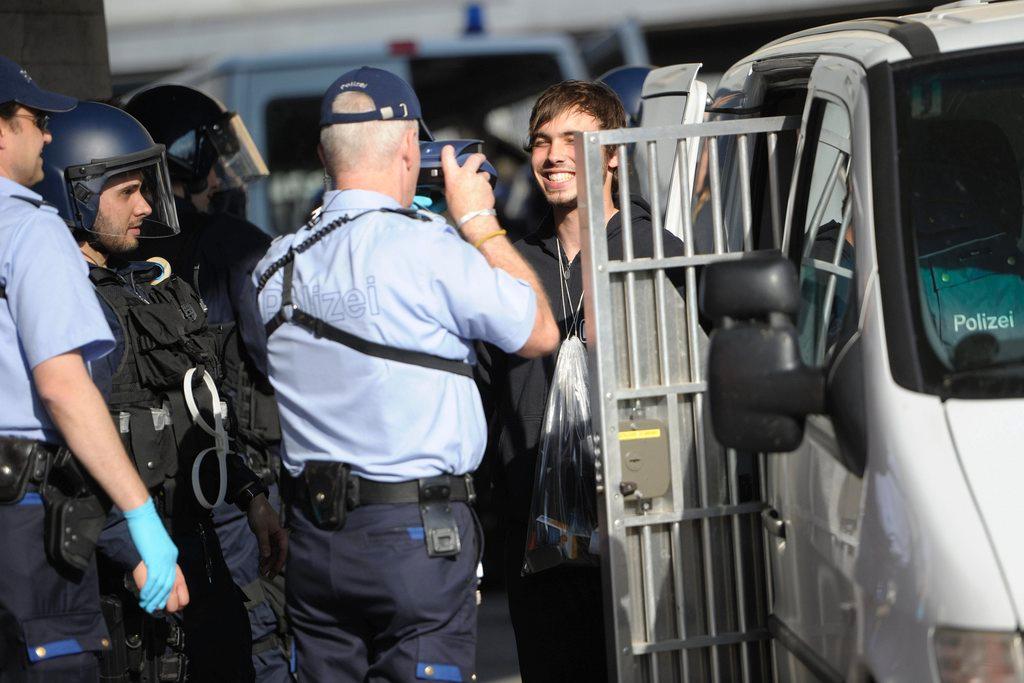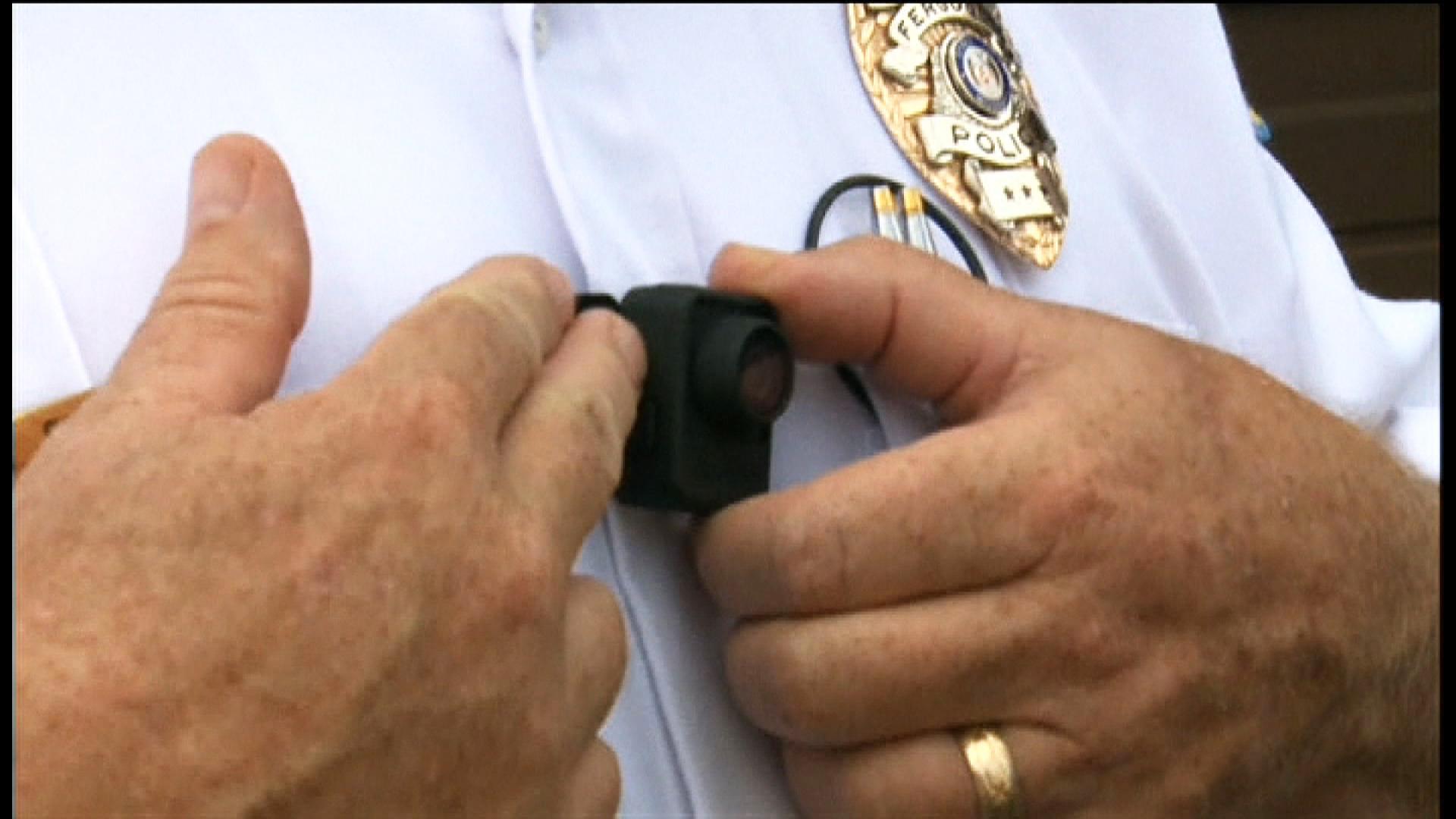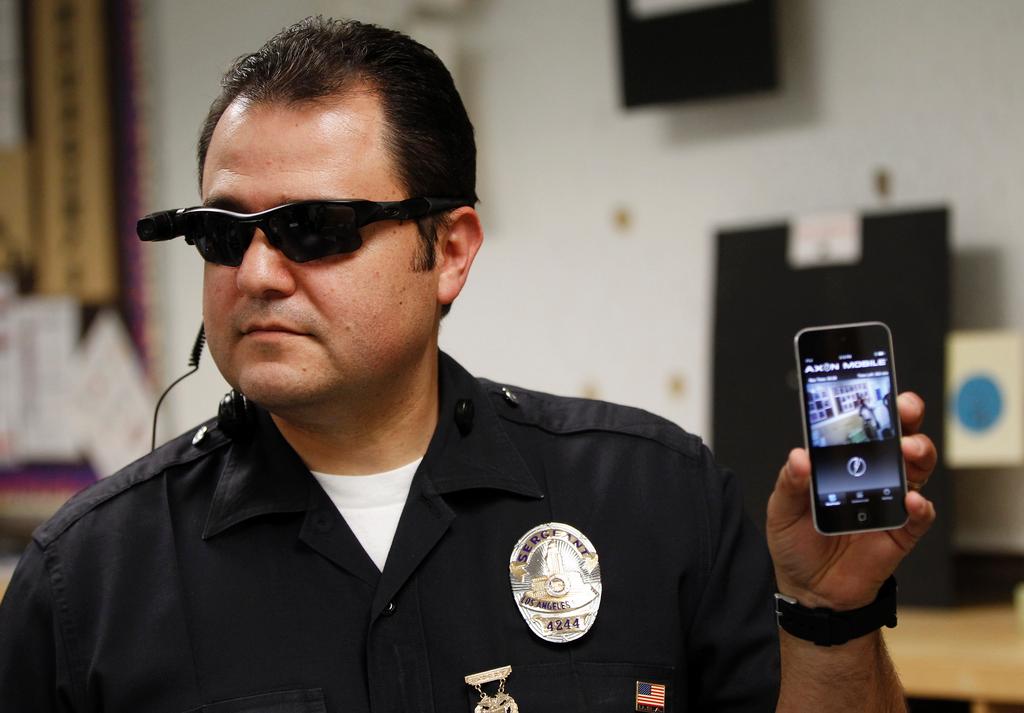Body cameras appear on police radar

Following riots in Zurich and Bern and allegations of police violence in the United States, talk has increased in Switzerland of making officers wear body cameras. swissinfo.ch looks at the legal and ethical challenges of this technology.
On December 12, 2014, around 200 masked leftwing radicals clashed with police in central Zurich, setting fire to cars and bins. Seven policemen were injured and hundreds of thousands of francs worth of damage were caused.
“Violence towards police has increased massively over the years,” Max Hofmann, general secretary of the Swiss Police Officers Federation, told swissinfo.ch. “In 2000, we had 774 incidents – violence or threats against officers. In 2013, there were 2,776.”
Cantonal police forces already use cameras to film sporting events and demonstrations or any other event with large crowds and the potential for violence. But Reto Nause, head of security for the city of Bern, which saw violent protests most recently in 2013, wants to go one step further: so-called body cams.
“I believe that during difficult police operations body cameras can help gather evidence and document the course of events better. They can also rebut accusations that a police officer has acted disproportionately,” Nause told swissinfo.ch.
He pointed out that the public could also benefit from such cameras, which can be attached to an officer’s helmet, glasses, shoulder or chest. “The question of proportionality obviously works on both sides. This would be a new evidence-gathering tool that could provide more clarity.”
In the US, the body camera debate recently heated up following two controversial civilian deaths at the hands of police officers (see box):

More
Could police cameras lead to more justice?
Positive experience
The few studies carried out into body-worn cameras suggest they reduce – but obviously do not eliminate – abuse.
Body cams were introduced to the police force of Rialto, California, in February 2012. A randomised control studyExternal link published a year later found that the number of complaints had dropped by 88% and police officers had used force nearly 60% less often.
As the New York Times observedExternal link, “when force was used, it was twice as likely to have been applied by the officers who weren’t wearing cameras during that shift”.
Elsewhere, German police in Frankfurt have worn €1,500 (CHF1,533) body cams since 2013. They are limited to using them in certain hot spots – such as areas with a lot of nightlife – and only during certain times; in addition, they have to announce that they are using them before they turn them on, and there is no sound.
Police commissioner Julie Rettenmeyer says police controls have run more peacefully since the introduction of the cameras.
Concerns
But not everyone is convinced. “Body cams violate a person’s private sphere, filmed by the police without permission. They are also to be rejected on data protection grounds,” Katrin Meyer from Augenauf (eyes open), an independent citizens’ rights organisation, told swissinfo.ch.
“Instead of putting cameras on helmets, police chiefs should look for ways of dismantling racism, sexism, xenophobia and uncontrolled aggression in the police force. And also how police officers who want to complain about their violent colleagues can get encouragement, protection and suitable first points of contact.”
Amnesty International is more open to body cams, admitting they could be a means of proving or refuting accusations of excessive police violence, but says it is very concerned by the trend of “technical upgrading” seen in many police forces.
“There’s always the basic question of proportionality: does the new means lead to the desired goal, and is the resulting restriction of personal rights really desirable in order to reach this goal?” Stella Jegher from the human rights organisation’s Swiss section told swissinfo.ch.
“The use [of these cameras] must in any case be limited to a very narrow framework, both for the individuals or units that are given them and also the occasions on which they can be used and for how long.”
In this respect, Nause agrees. “I think a patrol officer walking through the old town of Bern filming everything would be going too far.”

Cantonal issue
Data protection and transparency are two of the hottest issues when it comes to the use of police cameras.
“Body cams […] simply enable the police and other state institutions to gather more data and more control over the population,” Meyer said.
The situation is further complicated in Switzerland because each of the country’s 26 cantons sets its own surveillance laws.
In Bern, police cameras can only be used at large public events such as football matches or political demonstrations. In theory body cams can already be used at these events – and only these events – if the police commander orders it, says Markus Siegenthaler, data protection officer for canton Bern.
“If the police commander gives the word, it’s just a technical question of where on the body to wear them. But in order to make it like Frankfurt – where police can wear body cams in hot spots at certain times – it would be necessary for the cantonal lawmakers to expand the remit and create a corresponding regulation in our police law,” he told swissinfo.ch.
It is possible that the public would then have the final say if the decision were challenged in a referendum.
As for concerns about innocent members of the public being caught on camera, Siegenthaler said this was already the case for cameras monitoring stations, government buildings, prisons or other public buildings.
“The lawmakers solved this by saying the images could only be analysed by the police if there’s an incident – and then only during the exact timeframe of the incident. Otherwise the pictures can be stored for a limit of 100 days,” he said.
He gives the example of someone famous or in the public eye who is caught on camera stumbling half-drunk across a square. “That is in no way a matter for criminal law. The pictures have been recorded, but they cannot be viewed unless – at that very moment – something criminally relevant happens, for example the person is attacked,” he explained.
Working group
Hofmann says the Swiss Police Officers Federation has launched a body cam working group “so that if the politicians reach a decision – possibly without consulting us – we’ll be ready with facts and arguments”.
The group has already held its first meeting, but Hofmann does not know when its conclusions will be presented.
“We are prepared to hold a discussion about body cams, but we are demanding that the politicians involve us in the debate, otherwise we’ll be against them on principle,” he said, explaining that the federation’s members have concerns about always being on camera.
“That’s not acceptable – you can’t record a colleague the whole time.”
Siegenthaler concludes that the question facing lawmakers is: “do we want body cams, and in which framework do we want them?”
“From a basic constitutional and data protection point of view, it is possible to implement such a tool. In Bern we currently do not have a legal basis for body cams, but we could create one.”
US debate
On December 1, 2014, US President Barack Obama announced a $75 million (CHF68 million) plan to help police departments buy 50,000 body cameras. This came a week after a state grand jury decided not to indict a white officer in Ferguson, Missouri, for shooting to death an unarmed black teen, Michael Brown, in August 2014. This sparked protests and debates about excessive force, racial bias in policing and the use of body cams. This incident was not captured on camera.
Obama’s plan, which requires congressional approval, calls for departments to undergo training, receive guidance on best practices from the Department of Justice and submit a plan of use for approval. Civil rights and civil liberties advocates are wary of the lack of a federal enforcement plan.
On July 17, 2014, a white police officer in New York put an unarmed black man, Eric Garner, in a chokehold while attempting to take him into custody on charges of selling illegal cigarettes. Garner went into cardiac arrest and died. Despite the incident being captured on camera, on December 3 a grand jury decided not to indict the police officer.

In compliance with the JTI standards
More: SWI swissinfo.ch certified by the Journalism Trust Initiative












You can find an overview of ongoing debates with our journalists here . Please join us!
If you want to start a conversation about a topic raised in this article or want to report factual errors, email us at english@swissinfo.ch.